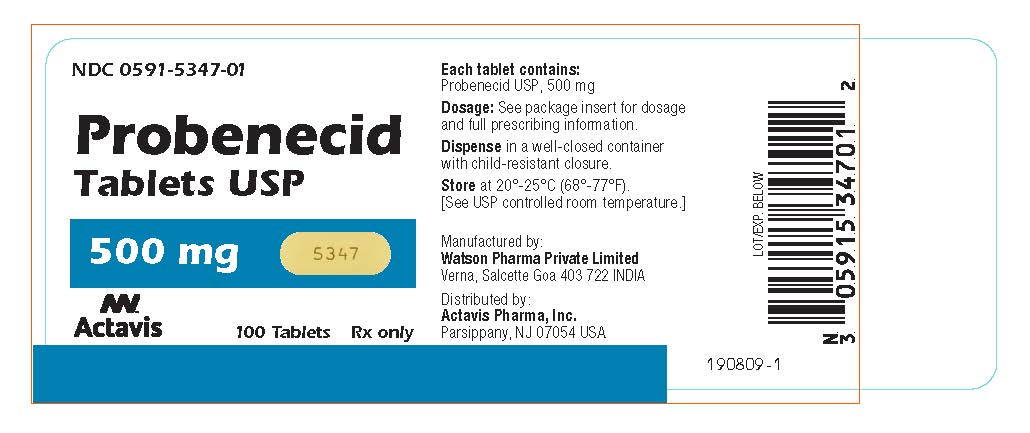Drug Catalog - Product Detail
PROBENECID TB 500MG 100
| NDC | Mfr | Size | Str | Form |
|---|---|---|---|---|
| 00591-5347-01 | ACTAVIS PHARMA | 100 | 500MG | TABLET |
PACKAGE FILES


Generic Name
PROBENECID
Substance Name
PROBENECID
Product Type
HUMAN PRESCRIPTION DRUG
Route
ORAL
Application Number
ANDA084442
Description
DESCRIPTION Probenecid, USP is a uricosuric and renal tubular transport blocking agent. Probenecid is the generic name for 4-[(dipropyl-amino)sulfonyl] benzoic acid. It has the following structural formula: C 13 H 19 NO 4 S M.W. 285.36 Probenecid, USP is a white or nearly white, fine, crystalline powder. Probenecid is soluble in dilute alkali, in alcohol, in chloroform, and in acetone; it is practically insoluble in water and in dilute acids. Probenecid tablets USP, 500 mg contain the following inactive ingredients: colloidal silicon dioxide, D&C Yellow No. 10 Aluminum Lake, FD&C Blue No. 1 Aluminum Lake, FD&C Yellow No. 6 Aluminum Lake, hypromellose, magnesium stearate, microcrystalline cellulose, polyethylene glycol, polysorbate 80, sodium lauryl sulfate, sodium starch glycolate and titanium dioxide. Structural formula of probenecid
How Supplied
HOW SUPPLIED Probenecid tablets USP, 500 mg are bisected, capsule-shaped, yellow, film-coated tablets imprinted DAN DAN and 5347 , supplied in bottles of 100 (NDC 0591-5347-01) and 1,000 (NDC 0591-5347-10). Dispense in well-closed container with child-resistant closure. Store at 20° to 25°C (68° to 77°F) [see USP Controlled Room Temperature]. Manufactured In India By: Watson Pharma Private Limited Verna, Salcette Goa 403 722 INDIA Manufactured For: Teva Pharmaceuticals Parsippany, NJ 07054 Rev. A 4/2024
Indications & Usage
INDICATIONS AND USAGE For treatment of the hyperuricemia associated with gout and gouty arthritis. As an adjuvant to therapy with penicillin or with ampicillin, methicillin, oxacillin, cloxacillin, or nafcillin, for elevation and prolongation of plasma levels by whatever route the antibiotic is given.
Dosage and Administration
DOSAGE AND ADMINISTRATION Gout Therapy with probenecid should not be started until an acute gouty attack has subsided. However, if an acute attack is precipitated during therapy, probenecid may be continued without changing the dosage, and full therapeutic dosage of colchicine or other appropriate therapy should be given to control the acute attack. The recommended adult dosage is 250 mg (1/2 tablet of probenecid) twice a day for one week, followed by 500 mg (1 tablet) twice a day thereafter. Some degree of renal impairment may be present in patients with gout. A daily dosage of 1000 mg may be adequate. However, if necessary, the daily dosage may be increased by 500 mg increments every 4 weeks within tolerance (and usually not above 2000 mg per day) if symptoms of gouty arthritis are not controlled or the 24 hour uric acid excretion is not above 700 mg. As noted, probenecid may not be effective in chronic renal insufficiency, particularly when the glomerular filtration rate is 30 mL/minute or less. Gastric intolerance may be indicative of overdosage, and may be corrected by decreasing the dosage. As uric acid tends to crystallize out of an acid urine, a liberal fluid intake is recommended, as well as sufficient sodium bicarbonate (3 to 7.5 g daily), or potassium citrate (7.5 g daily) to maintain an alkaline urine (see PRECAUTIONS ). Alkalization of the urine is recommended until the serum urate level returns to normal limits and tophaceous deposits disappear, i.e., during the period when urinary excretion of uric acid is at a high level. Thereafter, alkalization of the urine and the usual restriction of purine-producing foods may be somewhat relaxed. Probenecid should be continued at the dosage that will maintain normal serum urate levels. When acute attacks have been absent for 6 months or more and serum urate levels remain within normal limits, the daily dosage may be decreased by 500 mg every 6 months. The maintenance dosage should not be reduced to the point where serum urate levels tend to rise. Probenecid and Penicillin Therapy (General) Adults The recommended dosage is 2000 mg (4 tablets of probenecid) daily in divided doses. This dosage should be reduced in older patients in whom renal impairment may be present. Children 2 to 14 years of age Initial dose: 25 mg/kg body weight ( or 0.7 g/square meter body surface). Maintenance dose: 40 mg/kg body weight ( or 1.2 g/square meter body surface) per day, divided into 4 doses. For children weighing more than 50 kg (110 lb) the adult dosage is recommended. Probenecid is contraindicated in children under 2 years of age. The PSP excretion test may be used to determine the effectiveness of probenecid in retarding penicillin excretion and maintaining therapeutic levels. The renal clearance of PSP is reduced to about one-fifth the normal rate when dosage of probenecid is adequate. Penicillin Therapy (Gonorrhea)* In uncomplicated gonococcal infections in men and women (urethral, cervical, rectal), 1 g of probenecid should be given orally with 4.8 million units of aqueous procaine penicillin G ** (given IM), or 3 g of amoxicillin ** (given orally), or 3.5 g of ampicillin ** (given orally). For further guidance, see CDC recommendations for definition of regimens of choice, alternative regimens, treatment of hypersensitive patients, and other aspects of therapy. * Recommended by the Centers for Disease Control, U.S. Department of Health and Human Services, Public Health Service (Morbidity and Mortality Weekly Report Supplement, Volume 34, Number 4S, October 18, 1985). ** See package circulars of manufacturers for detailed information about CONTRAINDICATIONS , WARNINGS , PRECAUTIONS , and ADVERSE REACTIONS .
